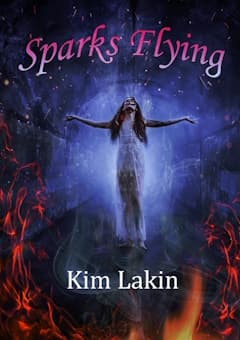
Sparks Flying by Kim Lakin
(Newcon Press, 2022)
Reviewed by Ksenia Shcherbino
Kim Lakin’s Sparks Flying is a truly miscellaneous collection of short stories: Victoriana and voodoo, cyber punk and morality play, grim industrial dystopia and deluge apocalypse, all the oddballs of deft imaginative writing crafted in evocative and distinct voices. Such an expanse of moods, ideas and genres left me with mixed feelings: this is not a book you can read in one go, instead, you keep returning to it, savouring one story at a time.
My favourite is a steampunk variation of Peter Pan, “The Island of Peter Pandora.” With the unthinking cruelty of a precocious child, Peter Pandora is playing God (or Dr Moreau) on a small island in the middle of nowhere. His lost boys are automatons, his pirates—the Rogues—are hybrid monsters he created by experimenting on dead animals, his main antagonist, Hookie—a family pet turned into antagonist through vivisection and animatronics. The palimpsest of Peter Pan, The Island of Dr Moreau and Frankenstein is poignant and powerful, and Lakin’s ingenuity is a treasure trove of conscious echoes and unconscious ripples. Peter’s sister, Bella, lives with the natives of the island, while Peter is tinker-ing with his boys, is it a linguistic vivisection of Tinkerbell? My inner reader claps in belief. Yet with all this intellectual guess making in the background, it is a story about loneliness and loss and despair, when a child scares himself with monsters not to feel scared of the real world.
Echoes of Peter Pan’s disillusionment with the world of adults can be found in another story, “The Harvest”, in a setting that reminded me of the original “Mad Max” movie. In a dystopian future where the Harvesters, mechanically augmented pirates armed with nets and sonic guns, attack a school to kidnap the children. And in line with Peter Pan mythology, grown-ups betray them—the head master and most of the staff cowardly hide. In the end, it is up to a steampunk kick-ass secretary—and one particular boy who seems to be immune to their weapons—to defend the school. A strong female fighter—a cliché with a twist—is a recurrent figure in Lakin’s stories: a similar pirate-fighting character would be central in “The Killing Fields,” another dystopia with bio-augmented pirates fights in rural England.
Lakin’s seeming fascination with Victoriana, hybridity and scientific experimentation is evident in another story, “The Goblin,” a loose version of Frankenstein set in space and re-instating the Beast in his power. The almighty scientist here is a pitiful secondary figure, a tool regretting his experiments. A healer on a planet saves a girl, the sole survivor of a spaceship crash, by genetic modification through introducing a shark’s gene into her body. But something doesn’t go quite right, or does it? Next time another ship crashes, and the girl wants a mate. It is up to the reader to decide whether death would be a preferable choice. While in Peter Pandora’s experiments, the human was overpowering whatever biomechatronics he created, here we see the monster gene overpowering the human.
An exploration of monstrosity lies at the core of another story, “The Shadow Keeper,” a ghost vengeance story rooted in Victorian fascination with freak shows and ‘unusual’ examples of human life. A man buys a servant at a fair—a giant child he mistakes for a grown-up woman. Moved by her deformity, he wants to give her a good life and enrols her in school, but children are intrinsically cruel, and she is bullied to death by a group of boys. Lakin describes her as “a natural Frankenstein’s monster with a swollen heart and inner darkness,” yet the story seems to question who the real monsters are.
Another vengeance story, “Rotten Things”, plays with voodoo magic and Southern folklore. Edmee is killed by her adopted family, and then is raised from the dead by the voodoo queen, Marie St Angel (based on Marie Laveau, a famous Louisiana herbalist and voodoo practitioner), to fulfil her revenge. Yet she takes too much fun in it—she is a lutin, a child who died before they were baptized, so Marie who helps the souls after death to pass to the other world has to intervene again. Lakin’s writing is surprisingly versatile, and this is one of the more horror-leaning stories in the collection, but I enjoyed the psychological tension and rich and gruesome details of Louisiana folklore.
There is also a Victorian story, based on the Pied Piper legend—“Field of the Dead”—a bittersweet lyrical piece with mummers playing Ghostbusters in the Lichfield cathedral that ends on such a sharp note that it made me cry. There is a certain quality to Kim Lakin’s stories that defies sentimentality, that is so common in Victorian and neo-Victorian works. She is razor-sharp, even ruthless, and somewhat punk-ish, similar to her characters—outcasts and castaways on the fringes of humanity, rebels and misfits who challenge the society to save it, like Eloise in “Deluge,” or take revenge on it, like Kitty in “The Shadow Keeper.”
Good writing comes in different words and visions, but it is always well-grounded. Lakin is one of those writers who know every detail of their world. Her interest in science and technology shines through: one of the finer details in the book are the short postscripts after each story where she explains the inspiration, and it is always a fascinating read to see how ground-breaking research is transformed into an edgy fantasy. And even though there were a couple stories that left me untouched—it is a book that I will definitely read again.
Review from BSFA Review 22 - Download your copy here.
